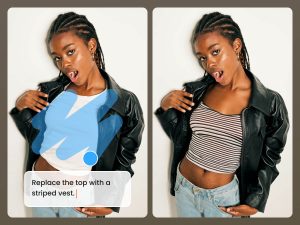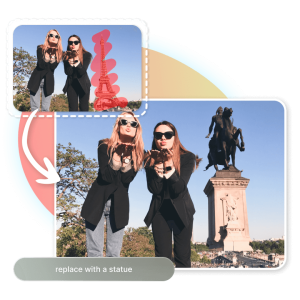Adopting innovative developments, the designers of our era use the surreal potentials of artificial intelligence. As smart software such as the ai image replacer is on the increase, changing and manipulating backgrounds and objects has leapfrogged the traditional way of doing it and you can bid farewell to working with the Photoshop lasso and clone tools through painful hours. The amalgamation of contemporary neural networks and generative technologies entrusts us with the power to transform a busy street in a metropolis into a secluded mountain road or change an umbrella into a neon flamingo within a few seconds. So why are replacement with seamless so game changing? Which are some wild and viable applications that creatives can take upon now? Now, how does this magic works?

The Way That AI Automatically Replaces Backgrounds as well as Objects
The background- or object-swapping process of AI does not only require cropping and pasting. You can compare it with a digital artist who has an endless imagination. Pre-trained AI models that are usually based on deep learning or GANs (Generative Adversarial Networks) perceive the structure, the lighting environment, and context of images. But when you request an ai image replacer to change the background of a scene, the system will study the colours, the angle of light and even the reflections or shadows of the objects.
Case in point: you need to transfer a character out of a dreary work place and into a sun washed cafe in Paris. The uses of the AI tools scan the location of the light source on the face of a subject and replicate the same on the new background of the cafe. Shadows, color grading, and perspective are harmonized as well they are usually made in one blink. During the olden days of photo-editing the fine merging could consume hours. Today, it is close to immediate.
The Hidden Technology
Now business. The newest image replacers are based on some more important technologies:
Deep Convolutional Neural Networks (DCNNs): These models detect edges, contours and objects in an image. They will assist AI to separate what you desire to maintain, and what you desire to modify say magic scissors.
GANs: GANs are not like the traditional algorithms because they operate in pairs. One is a network of creating images, and the other is a network of criticism. Such a contest brings every output nearer to photorealism.
Contextual Inpainting: Removal of objects occurs; as an example, it: an AI will be filled in the remains of an erased road sign. None of the pixellated patches, only cleverly rendered information that accepts the original pattern and texture.
An AI-exclusive survey released by Adobe in 2023 showed that 57 percent of professional designers currently are utilizing some element of AI in digital composition. That is not a fad, that is an earthquake.
Use Cases that are Practical, Funky and even Jaw-Dropping
Lightning-Fast Prototyping

Mockups used to take hours of searching the stock photos and assembling the scene. Not anymore. To see how you product will look on the beach, in the kitchen or at a fancy gala, find out here. AI has the capability to replace new backgrounds and objects in a snap. Designers have gone to warp speed in showing clients many ideas. Fussy clients? All one had to do to change the pattern on a scarf in a catalog shoot to stripes to paisley is just one click.
The Individualized Visual Storytelling
Consider social media campaigns in which each of the followers plays the role of the center in an actual spotlight. AI allows brands to allow the user to simply upload a selfie that would then be cast into advertisements, posters, or even magical scenes. Suddenly, your face will be in a superhero film, or even laying down on a tropical beach without any green screens.
Movie and Advertising Magic
Do you remember continuity errors when people have to be reshooted or find last-minute replacements because they had to change location? That is the rulebook that AI rewrites. Movie makers no longer have to reshoot after adding debris in ugly backgrounds, eliminating background passerbies or introducing objects in the background. Seasonal backdrops can make up-to-date branding only in several minutes (pumpkins change into snowflakes). Digital artists go so far as to revive icons in aged film and incorporate them into contemporary scenes in a bid to make viral nostalgie captures.
Application/Web Adaptive Design
Creators of web design are able to develop regionally appropriate backgrounds and objects in shortest period of time. As an example, an online shoe store can have boots going through the snow-covered and invaded sceneries in Canada and on wet and rainforests in Brazil with only the same foundation photograph that is dynamically altered with the use of AI image replacer.
Strange Fine Art and Collage Work
Artists are merrily bursting through the visual box. Surreal sceneries, surreal collusions, compared to Dali he creates, creators, overlay, over-mix and change the idea in a way and speed previously inconceivable. Novice artists are making visual mashups with the same quality as top professionals using only the faintest technical knowledge.
Accessibility Expansion

Artificial intelligence is not only exciting, but there is a nice side to it as well. The alternative scenes produced by designers now (which are more useful to the visually impaired users) are produced by designers (such as high-contrast or descriptive backgrounds). Learning graphical designers substitute backgrounds with streamlined ones to make learning easy.
Problems and Traps: It is not Always Flowering
Although roadblocks emerge, it seems like replacing images are an easy affair with the assistance of AI. In some cases, AI finds it hard to handle strange lighting conditions, complex hair, and fancy reflections on glass. Not all characters fall gracefully into a new scene. The quality control is not forgottenโensk>, even the most intelligent neural net occasionally sees strangeness into a picture.
There have been some public disasters in which crowd groupings created by AI featured four-armed people or cyclists in sagging faces. It is a reminder of the fact that machines can do imitations of artistry but it still requires a human critic to get them in check.
